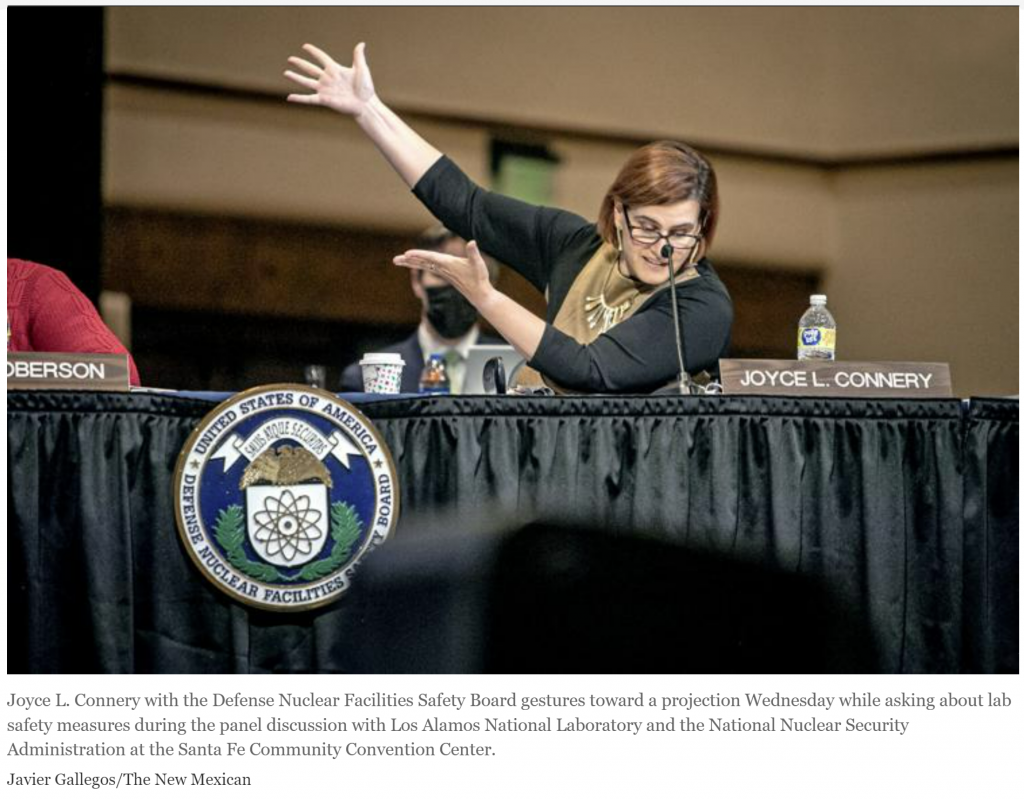[NukeWatch would amend this headline to add “‘lightly’ grills” – The DNFSB was asking tough questions, but DOE and the LANL contractors were not forthcoming with those answers.]
“Much of the discussion involved complex, technical subjects. But board Chairwoman Joyce Connery said a basic complaint is the lack of response the board has gotten at times when raising concerns in letters sent to the lab and nuclear security agency.”
THE SANTA FE NEW MEXICAN | November 16, 2022 santafenewmexican.com

A federal watchdog agency on Wednesday grilled top officials from Los Alamos National Laboratory and the agency that oversees nuclear weapons about ongoing safety concerns and how they aim to resolve them as the lab gears up to produce an unprecedented number of warhead triggers.
The Defense Nuclear Facilities Safety Board, an independent organization within the executive branch, questioned lab Director Thom Mason and National Nuclear Security Administration head Jill Hruby about safety issues that could prove important as the lab moves toward making 30 bomb cores, known as pits, per year by 2026.
The board provides recommendations and advice to the president and the secretary of energy regarding public health and safety issues at Department of Energy defense nuclear facilities.
The daylong hearing was held at the Santa Fe Community Convention Center. It is the first time in several years the safety board has held a public hearing in the Santa Fe area.
Some questions focused on how well the lab’s 44-year-old plutonium facility, which is being modernized for pit production, would fare in an earthquake. Others probed what the lab was doing to establish a workforce able to safely carry out the mission of making pits to upgrade the nuclear stockpile.
Questions included why the lab is forgoing an air confinement system that would better prevent a radioactive release, whether its sprinkler system could extinguish a sizable fire and how the lab could minimize the amount of waste stored outdoors when pit production begins.
Much of the discussion involved complex, technical subjects. But board Chairwoman Joyce Connery said a basic complaint is the lack of response the board has gotten at times when raising concerns in letters sent to the lab and nuclear security agency.
“We don’t always get answers,” Connery said. “The nature of our questions is not designed to be adversarial. We have an important mission to do.”
Much time was spent discussing the system for containing a radioactive release in the rare event of an earthquake causing a fire at the lab’s plutonium facility.
The board first pushed for a safety-class system in a letter it sent to nuclear security managers in 2004. Christopher Roscetti, the board’s technical director, went into more depth about why this system was better than the one now in place.
A safety-class system would continue to function during an accident, ensuring radioactive material is captured by filters before it could be released into the environment, Roscetti said.
Mason said the current system has had enough safety-class components installed in it to offer “robust” protection.
Hruby said replacing the system entirely could take three years, which would cause too much of a delay in modernizing the stockpile to strengthen the nuclear deterrent. But, she added, they are doing “lots of other things” to ensure the facility is safe.
“I feel like we are careful about the risks we’re accepting,” Hruby said. “We’re approaching this in a responsible manner.”
The board displayed a photo of yellow tape covering a device stretching between the floor and ceiling. The caption said visual inspections done every three years without additional monitoring of aging devices, coupled with a “run until failure” mentality, poses a significant contamination risk and a hazard to workers.
Hruby said that must be addressed and can’t continue.
Board member Jessie Hill Roberson praised the lab for clearing out barrels of waste from an outdoor site, but she questioned what will happen when the lab generates more waste from pit production.
Theodore Wyka, who manages the nuclear agency’s Los Alamos field office, said the number of waste shipments to a permanent underground disposal site near Carlsbad has increased from one per week to as many as three.
Mason said crews have gotten more efficient in maximizing shipments, which includes putting legacy waste and newly produced waste on the same truck, something not done in the past. All of these practices reduce the amount of waste kept at the lab, he added.
The board also pointed out the lab’s current glove boxes — sealed compartments workers use to handle radioactive material — were not designed to withstand an earthquake.
Mason said the lab has begun to replace the glove boxes with ones that are up to seismic code, adding the only thing slowing the process is the vendors’ limited supply.
A fair amount of time was spent discussing the lab’s staffing challenges. Having an adequate, well-trained workforce will be vital in fulfilling the pit-production tasks safely and efficiently, board members said.
Both Hruby and Mason said worker recruitment and retention have become more difficult, but they are looking at ways to improve both.
Despite the challenges, the plutonium facility has increased its yearly production period to 30 weeks from 19 weeks in the past two years, and will push toward the goal of 40 active weeks a year, Mason said.
“We’ve made progress, but more work remains to be done,” he said.
